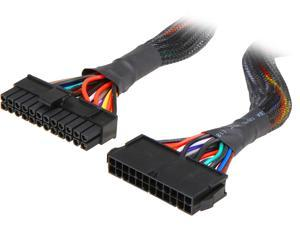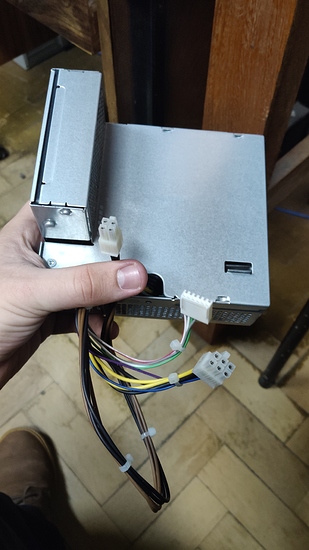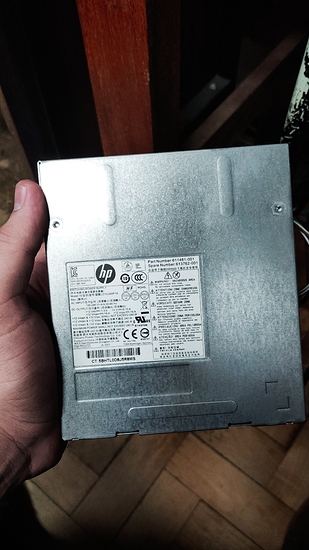Earlier today we received this HP Compaq machine for testing, the people responsible for it said “it worked yesterday, but today it doesn’t even turn on”, alright, we checked and it really doesn’t.
I wanted to do the jumper trick on the PSU just to make sure it turns on, however on this one i have no idea how you’re supposed to do it, it only has these 3 connectors.
Does anybody know how i can jump start it?
Its apparently made by Chicony, if it helps.
do you have a model number?
The MB dying first is almost always a safe bet
For the computer itself?
Model: Compaq Pro 6305 SFF
P/N: QZ7110AV#138
Found some on the PSU:
P/N: 611481-001
S/N: 613762-001
Found this
http://www.pcdoctor-community.com/forum/index.php?topic=294.0
This kinda looks useless:
step 4: replace power supply
step 5: replace motherboard
from section 8-2
http://h10032.www1.hp.com/ctg/Manual/c03916058
Wish I could help more but I’m at my wits end
no idea if this would work

Thanks a lot for the help!
I’ll see if i can borrow one of these PSUs with somebody, seems like the most plausible idea.
An analog one, yes.
That’s perfectly fine.
The green wire is normally the PS_ON pin (power supply on). You can simply check that it is that pin for this power supply by plugging the power supply into mains, and checking the voltage between the green pin and the black pins (ground).
What should i look for, 12v?
Nah, PS_ON is generally around 2.5-4v in my experience (varies between OEM). If there is voltage on that green wire, then my bet is that it is PS_ON, and it will be safe to short that pin to ground!
The worst that can happen if that isn’t the PS_ON pin (and instead is a always-on voltage line) is that the over current protection trips of the PSU, and the PSU shuts off completely.
Edit: A simple paper clip or staple is what I normally use to short the PS_On pin to ground. It’s somewhat ghetto, but gets the job done.
If you’re worried that you’ll get an “electric shock” by touching any of those wires while the PSU is on, you won’t. There is isolation between the primary (mains) and secondary (“low voltage”) side, preventing you from getting a shock, plus, the voltage is so low, and your bodies resistance is so high, that the amount of current flowing through your body will be unnoticeable (technically measurable, but still completely safe).
Should not exceed 20uA (micro Amps), wich is far less than licking a 9V block.
Just got here, did as you said and nothing, not even propped the needle on the multimeter.
Tried jumping with the green wire connected to the black wire, no success either.
Thanks for the help!
Sounds like that it is likely a dead PSU, and the motherboard is likely fine. If you wanna investigate further, you can; here’s what I would do.
Do you have an ampmeter/kill-a-watt?
- If you have a kill-a-watt/similar device, see if any power is being pulled from the wall.
- If you have an ampmeter, find a way to connect the power supply to the wall, but have the ampmeter in series, to measure if the PSU pulls any current from the wall.
At idle, the PSU should pull around 9-50mah @120v (1W-6W). If it is pulling power, that means the main input fuse is NOT blown. If there is no power being pulled at all, then the fuse is blown.
If the fuse is not blown, i’d probe all the different coloured pins, to see if any power at all is flowing to the PSU output (since there are multiple rails to a PSU; the PS_ON rail, a 5V standy rail, and others). If no power is flowing to any of the pins of the PSU, that guarantees that the PSU is fucked.
PSU’s have (generally) two states; powered on, or idle. At idle, there are a few power rails which output a voltage, one of which is waiting to be (normally) pulled to ground, to tell the PSU to turn into the “powered on” mode (which then activates the main 12v, 5v, and 3.3v rails). Without any voltage at any of the pins, then the PSU is definitely dead.
Unfortunately i don’t have either.
At this rate i think its easier to borrow a PSU from a similar machine and see what it does.
If you have one available, then yeah, that would definitely be easiest lol
I think i can borrow one from a guy that parts out these kinds of machines, I’ll see if he can lend one for a few hours
many of the psu’s have a fuse inside (generally soldered leads) that can be replaced but you need to find out what overloaded it in the first place.
a psu can be repaired but it isa task that you must know what you are doing.
more often than not its costs less to just replace the psu than it does to have it repaired.

